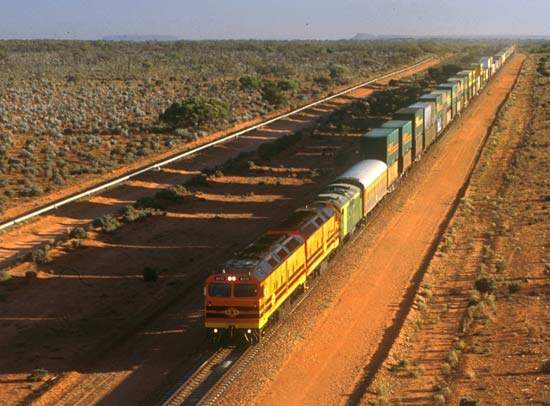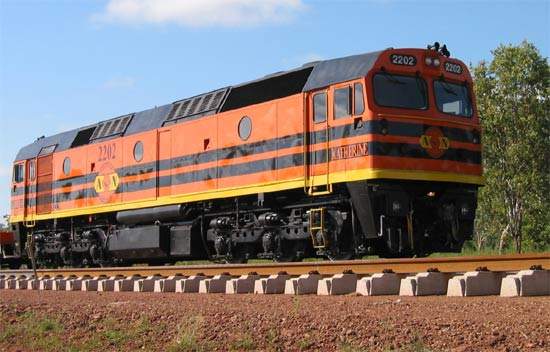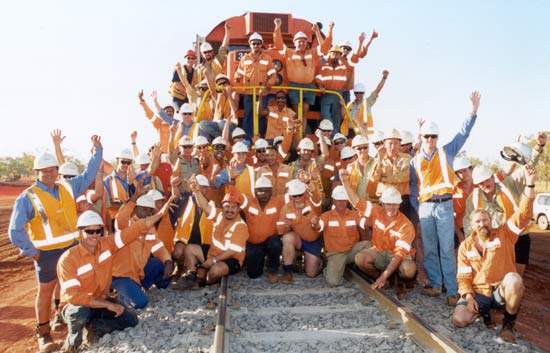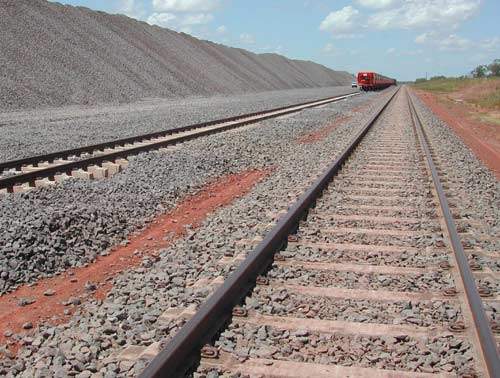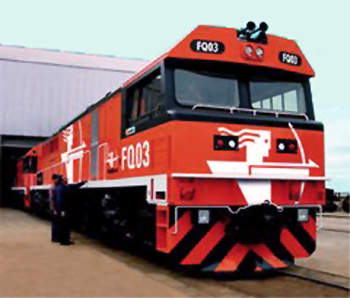Envisaged in 1911 with the creation of the Northern Territories, the 1,420km (880-mile) line between Alice Springs and Darwin in Australia’s Northern Territory was completed on 17 September 2003.
Completing the national rail network, the line connects the deepwater port of Darwin with the south of the country and created a freight landbridge to Asia and the rest of the world.
The project
The Alice Springs-Darwin scheme was managed by the AustralAsia Railway Corporation, an organisation set up by the South Australian and Northern Territory governments.
Using a build, own, operate and transfer back (BOOT) project basis, Asia Pacific Transport won the commercial tender with ADrail as its design and construction arm and FreightLink, its operating arm. The operation aspect covers the combined 2,240km of the line projects between Tarcoola and Darwin.
A financial contribution of A$191.4m came from the Federal Government. The South Australian and Northern Territory governments contributed A$367.8m, the rest coming from the private sector. Public funding related to the construction of the line and not to operating costs. The Melbourne-based independent think tank, the Institute of Public Affairs, criticised Government funding for what they considered offered prospects for returns.
A new 830km (516-mile) standard gauge line to replace the inadequate metre gauge track along a less flood-prone route, had been completed between Tarcoola, South Australia and Alice Springs in 1980, this transferred under lease for through operation to Darwin as part of the new project. The Commonwealth Government pledged to support preliminary work and design for the last section to Darwin.
Construction began in 2001 and was to cost A$1.2bn. The corporation attained its obligation of at least 75% of the project value on goods and services being sourced within South Australia and the Northern Territory, including sub-contracting and labour-hire. Freightlink unsuccessfully sought extra long-term investment for an equity stake in the business during 2006.
Infrastructure
Extensive negotiations preceded construction. The corridor encompasses 219km of Aboriginal Land Trust Land and 252km of land under claim under the Aboriginal Land Rights Act. Most of the remaining distance crossed land in which Aboriginal people hold title rights.
It was a massive logistical exercise to overcome the difficulties of building a new railway across some of the most inhospitable terrain in the world, with summer temperatures reaching 50ºC and a three-month monsoon season.
Site work began in April 2001 and tracklaying 12 months later. Construction depots were set up at Katherine and Tennant Creek and teams worked towards each other at the 800km mark. The teams worked north from Katherine to Darwin and south from Tennant Creek to Alice Springs. This minimised the distances work trains had to travel and accommodated the impact of the summer rainy season in the tropical north. Up to 2km of track was laid per day. To reduce collision risk, there are five grade-separated crossings of the Stuart and Victoria highways.
For most of its length, the line runs along a simple 1m-high embankment across the plains of the Tanami Desert. Continuous welded rail on concrete sleepers is used throughout and the line is being built for 23t axle loads with clearances for double-stack containers and a maximum speed of 115km/h (71mph).
The track network is integrated with Darwin’s new East Arm Port which includes a railway embankment and intermodal container terminal. A temporary passenger station was built there, adequate for the start-up service. The authority reserved A$9m for the purpose of building new passenger station facilities.
Rolling stock
Four Class GT46C FQ class locomotives were supplied by GM-licensees Clyde Engineering (subsequently EDI Rail) with the opening to Darwin. The single cab units in FreightLink livery are fitted for multiple-unit working. Class G6B locomotives are stationed at Darwin and Alice Springs for shunting.
Freight and passenger services
The rationale for the Darwin extension was primarily based on freight flows, the project sponsors identifying ‘time-sensitive and high-value commodities’ as likely cargo, including meat, dairy, vehicles, wines, high-technology and consumer items. From 2008 FreightLink runs six mixed Adelaide-Darwin freight services, run weekly in each direction, some extending to Melbourne. Within the Northern Territory these were joined in May 2006 by dedicated mineral trains of manganese ore from Bootu Creek mine. FreightLink provides logistic support for deployments by the Australian Defence Forces.
Passenger services are operated by Great Southern Rail who pay an access charge run twice-weekly in each direction. The ‘Ghan’ is an established brand in the Australian tourism market that connects with Indian Pacific and the Overland (from 2007) long distance services. Taking just under two days Darwin-Adelaide with an extended Alice Springs stop, passenger trains include car carrier vehicles.
The future
Having secured about 90% of the freight carried between Adelaide and Darwin, in May 2008 FreightLink announced that it intended to sell the business, appointing financial services company UBS to advise on the process.
Some reports suggested the sale decision was prompted by investors who were concerned over the profitability of the operation.
For financial year ending June 2008, FreightLink reported an 18% increase in intermodal traffic and expected to carry 800,000 of general freight.

